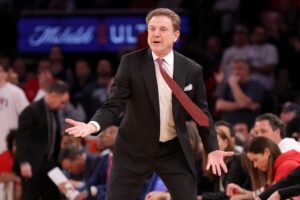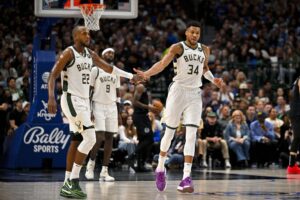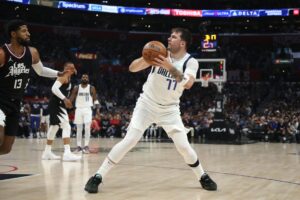Because of the nature of professional sports, players must constantly look over their shoulder. Every draft brings a new labor force; every season brings new challenges. The battle for roster spots on an individual level is obvious. But it exists on a team level as well. And in that sense, the Milwaukee Bucks have become the measuring stick for the rest of the league. Their ascension up the ranks in the Eastern Conference – and the NBA as a whole – has put the league on notice. It’s why the Milwaukee Bucks playoff run starts now.
Milwaukee Bucks Playoff Run Starts Now
To be sure, the NBA has its elite tier: the Cleveland Cavaliers, Golden State Warriors, and San Antonio Spurs. (You could add a couple teams to that title-contending group, depending on how saucy you’re feeling. But they’d be underdogs of the highest degree.)
As for the rest of the field, it’s the Bucks that head the group as the team in the best position to peak once Cleveland starts trending down, and when (or if) Golden State and San Antonio have to start picking which players to give massive contracts to and who is expendable. Which is to say: Dynasties don’t last forever. And in the case of the NBA, it’s probably the prudent move at the moment to wait it out a few years and take advantage of the general lack of depth when it comes to the top tier of teams, and their inevitable vulnerability. Milwaukee is set up to compete for championships in the post-LeBron/Warriors world perfectly.
The Budding Superstar
Describing Giannis Antetokounmpo as a “budding” superstar could be considered slander, given his performance thus far this season. But he is still 22, and in the process of figuring things out – not only his game, but life in general. General managers around the NBA, interestingly enough, were posed the question “If you were starting a franchise today and could sign any player in the NBA, who would it be?” prior to the start of the season. Karl-Anthony Towns received the most votes, taking in 48.3% of the total. He was followed by Kevin Durant and LeBron James. Stephen Curry, Anthony Davis, Kawhi Leonard, and Russell Westbrook made up the “also receiving votes” group.
If that poll were conducted today, Antetokounmpo might be atop the list. With apologies (and a healthy amount of respect) to Towns and Davis, the “Greek Freak” is the best player in the NBA under the age of 25. At least at the moment. Antetokounmpo bests Davis this season in Win Shares by a margin of 6.6 to 5, per Basketball-Reference. Those GM poll results only emphasize how surprising Giannis’ growth as a player is. Last season, he was an intriguing, raw prospect to keep an eye on. Next season, it’s possible that he’ll be regarded as a top-five player in the league.
The Second Star
Some people mistakenly attribute multiple stars playing on the same team a recent trend. That’s simply not the case. In fact, it’s the opposite. You can count the number of NBA championship-winning teams that haven’t had two or more Hall of Famers on one hand – without using all your fingers. Milwaukee’s sidekick to Antetokounmpo comes in the form of Jabari Parker.
The Bucks have to be a bit careful with Parker, however. Small markets that develop two superstars have struggled to keep both on board. For example, LaMarcus Aldridge left Portland when Damian Lillard seized the spotlight. When Kevin Durant was in Oklahoma City, there were countless reports of his relationship with Russell Westbrook being far from perfect. Whether those reports were founded on truth or not doesn’t really matter at this point, as Durant isn’t there anymore. Milwaukee needs to keep Parker happy. These things can be more fragile than a lot of people think.
New CBA Brings Additional Hope
In a stroke of luck, the Bucks could stand to benefit more than any other team (at least in the relative short-term) when the NBA’s new Collective Bargaining Agreement kicks in. Why? Because the new CBA incentivizes players to stay with the team that drafted them even more than the current one does. For as long as the Bucks think he’s worth the money, Jabari Parker will get offered the most money and the most contract years to stay in Milwaukee.
Additionally, the Bucks also have the added fortune of having injured guard Khris Middleton’s contract decrease in the coming years. The fact that, as far as the amount of money is concerned, this is the peak of Middleton’s deal (at $15,200,000) is a godsend as it pertains to future cap flexibility.
While we’re on Middleton: He’s been the best player for the Bucks for the last few years. However, a hamstring injury has shelved him thus far. He’s on track to come back sometime after the All-Star break. When he does, he’ll be – at best – the third option on offense. Although not an acquired addition, Middleton could be one of the best pick-ups any playoff team gets this season. His defense and three-point shooting are areas of need for Milwaukee. Middleton has never made an All-Star team, but he has played at an All-Star level before. A reduced role could make the already super-efficient guard even more so. It’s up to him, though – and, to a lesser extent, Antetokounmpo and Parker – to make it work smoothly when everyone is healthy.
The Surprise Rookie
The Bucks use Antetokounmpo as their point guard, but that’s really a meaningless label. He’s the Bucks’ primary ball handler, and that gets him “point guard” status, despite playing a hybrid of guard/forward. Milwaukee is best-served utilizing a position-less lineup that is en vogue with many NBA teams these days. However, on the defensive end, a more traditional point guard is needed, because playing Antetokounmpo as a true point guard would waste his defensive versatility. Insert: Malcolm Brogdon.
Every team in the league could use a player like Malcolm Brogdon. He plays within himself, always in control, and makes fundamentally sound plays. He can occasionally make a highlight play, too. Many rookies struggle with the speed of the NBA game, but when Brogdon has the ball, the game moves at his speed.
The Bucks snagged the Virginia product in the second round of the draft. Viewed as having limited upside because he (gasp!) stayed in college for four years, Brogdon was last season’s ACC Player of the Year, averaging 18.2 points per game, but didn’t hear his name called until the 36th pick. Basically, every team that passed him up did so for a more unknown commodity. (The lesson, courtesy of Peter Griffin: If you want a boat, take the boat, don’t choose the mystery box.)
The Rest of the Herd
Milwaukee sort of backed into realizing the value of Greg Monroe. Sure, no team would choose to have a max salary guy coming off the bench, but Monroe provides a scoring threat on the second unit of which very few teams have the luxury. While being a lesser player overall, John Henson allows Milwaukee’s starting unit to play with the pace they otherwise couldn’t, while offering a good amount of rim protection.
This past calendar year, it was the NBA’s worst-kept secret that the Bucks wanted to trade Monroe, given his awkward fit in the starting unit. But he might just mess around and win himself a Sixth Man of the Year award this season.
When Milwaukee’s second unit comes in, they slow the game down and play entirely around Monroe’s strengths. (This also brings a bit of a nightmare for opposing coaches. No team presents such a yin-and-yang style contrast between their starting and second units like the Bucks do.)
The Infrastructure
Although a bit head-scratching upon first glance, the acquisitions of Matthew Dellavedova, Jason Terry, Mirza Teletovic, and (yes) even Michael Beasley have been nothing short of genius. Even though Dellavedova’s minutes will probably decline with the emergence of Brogdon, he and Terry bring much more to the locker room than they do the court. The younger Bucks consistently praise their elders for challenging them and setting a high standard of professionalism for the entire team. Teletovic and Beasley bring additional scoring threats off the bench and aid the Bucks in certain situations when they can take advantage of particular match-ups.
Some young, rebuilding NBA teams shy away from bringing in older veterans like the Bucks did. But in doing so, the younger Bucks are maturing in ways they might not have otherwise. (Need an example of why letting young players fend for themselves with no veteran guidance is a bad idea? See: 76ers, Philadelphia.)
A Drastic Change in Expectations
At one point a few years ago, the Milwaukee Bucks were the leading candidate to provide an existing team that could turn into the next incarnation of the Seattle SuperSonics. (If you happen to have a drink in your hand right now, pour out a little for our friends in Seattle.)
Professional sports can make for strange allegiances. For an example of that, look no further than the bright future of Milwaukee’s basketball team now being nestled in the hands of a couple of hedge fund billionaire owners from New York, a star on the rise from Chicago (the city that offers the foil for the city of Milwaukee’s little brother complex), and a player of endless potential who grew up on the streets of Greece in tremendous poverty.
A new basketball arena will soon open in Wisconsin‘s Queen City. But the Bucks might as well play in the open air of Lambeau Field so they can occasionally look up into the endless sky as a symbol of their potential together.
With any luck, that new arena in downtown Milwaukee just might be the next Eastern Conference site outside of Cleveland to host an NBA Finals game. The Milwaukee Bucks playoff run for this season starts now, and it might not end for a decade.
Main Photo:
NEW YORK, NY – APRIL 10: Giannis Antetokounmpo of the Milwaukee Bucks looks on against New York Knicks at Madison Square Garden on April 10, 2015 in New York, New York. (Photo by Cem Ozdel/Anadolu Agency/Getty Images)






